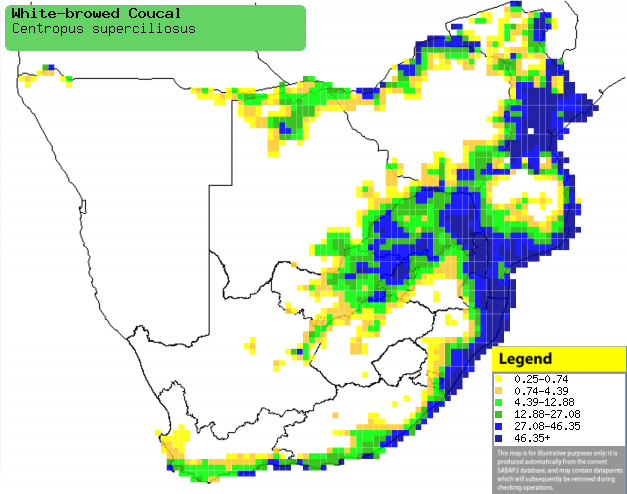|
Centropus superciliosus
(White-browed coucal)
Gestreepte vleiloerie [Afrikaans]; Wenkbrauwspoorkoekoek
[Dutch]; Coucal à sourcils blancs [French]; Weißbrauen-spornkuckuck [German]
Life
> Eukaryotes >
Opisthokonta
> Metazoa (animals) >
Bilateria >
Deuterostomia > Chordata >
Craniata > Vertebrata (vertebrates) > Gnathostomata (jawed
vertebrates) > Teleostomi (teleost fish) > Osteichthyes (bony fish) > Class:
Sarcopterygii (lobe-finned
fish) > Stegocephalia (terrestrial
vertebrates) > Tetrapoda
(four-legged vertebrates) > Reptiliomorpha > Amniota >
Reptilia (reptiles) >
Romeriida > Diapsida > Archosauromorpha > Archosauria >
Dinosauria
(dinosaurs) > Saurischia > Theropoda (bipedal predatory dinosaurs) >
Coelurosauria > Maniraptora >Aves
(birds) > Order: Cuculiformes
> Family: Centropidae
The White-browed coucal is fairly common in Zimbabwe,
Botswana and Mozambique, living in thick vegetation. It feeds on a wide a wide
variety of animals, such as mammals, birds and insects. The nest is large sphere
with a side entrance, made of grass blades or stems. It lays 3-5 eggs, which are
incubated by both sexes, for 14-16 days. For the first three days of their life,
the chicks are brooded by one parent, and fed by the other, after which both the
parents do the hunting. The brood leave the nest at 18-20 days old, the
fledgling period has not been studied.
Distribution and habitat
Occurs from Ethiopia south through Uganda, Kenya and
Tanzania to southern DRC, Angola, Zambia and southern Africa. Within southern
Africa it is fairly common in northern Namibia, northern and south-eastern
Botswana, the exterior of Zimbabwe, Mozambique and north-eastern and southern
South Africa. It generally prefers reedbeds,
seasonal pans and thickets with dense grass near water.
|
 |
|
Distribution of White-browed coucal in southern Africa,
based on statistical smoothing of the records from first SA Bird Atlas
Project (©
Animal Demography unit, University of
Cape Town; smoothing by Birgit Erni and Francesca Little). Colours range
from dark blue (most common) through to yellow (least common).
See here for the latest distribution
from the SABAP2. |
Food
Feeds on a wide variety of animals,
including insects, small mammals and birds. It does most of its foraging in thick vegetation,
sometimes flying down to the ground to pick up a prey item. It may also catch
animals flying from a bushfire. The following food items have
been recorded in its diet:
- Invertebrates
- Vertebrates
- small birds up to the size of doves,
- mice
- reptiles
- tree frogs
Breeding
- The nest is a large, untidy sphere-shaped structure, with a side
entrance and entrance ramp. It is built of grass blades and stems and lined with
leaves and roots, typically placed 0.5-10m above ground in reeds, a
bush or a tree.
- Egg-laying season is normally from September-March.
- It lays 3-5 eggs, which are incubated mainly by the male for 14-16 days.
- For the first three days of their lives, the chicks are brooded by one
parent and fed by the other, after which both the parents do the hunting.
The brood leave the nest at about 18-20 days old.
Threats
Not threatened.
References
-
Hockey PAR, Dean WRJ and Ryan PG (eds) 2005. Roberts
- Birds of southern Africa, VIIth ed. The Trustees of the John Voelcker
Bird Book Fund, Cape Town.
|
